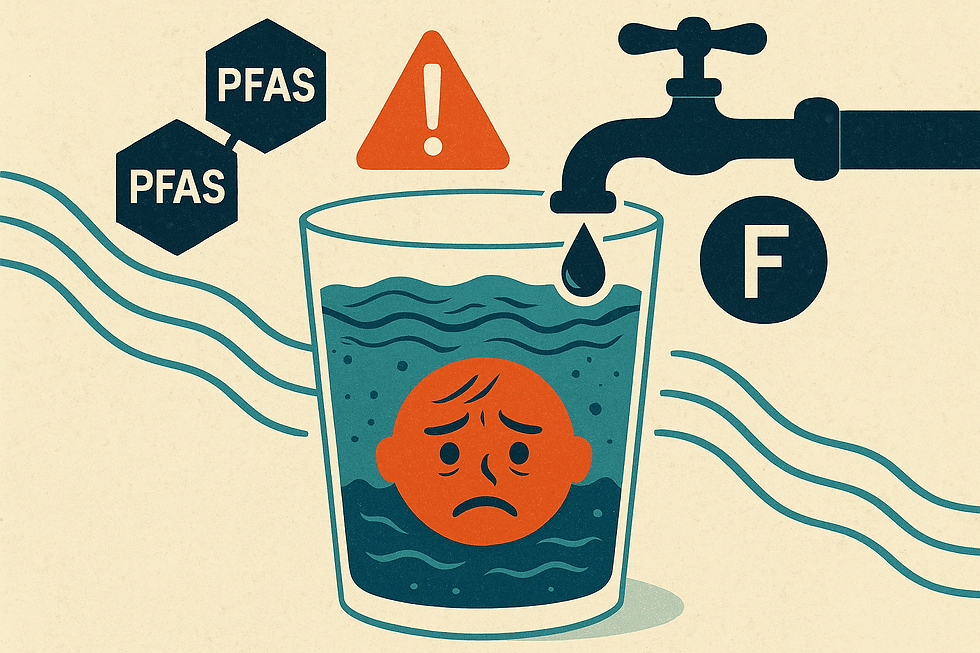The Chilling Truth About What’s Hiding in Your Water
- Oct 7
- 3 min read

When the Most Terrifying Things Are Invisible
Pumpkins, costumes, haunted houses, Halloween gives us all kinds of thrills. But the scariest thing you might face this year isn’t hiding behind a door. It’s flowing through your plumbing, sitting in your glass, running through your daily routine. What looks like clear, safe water often hides a mixture of industrial residues, hormone-disrupting chemicals, microscopic parasites, and plastic fragments. You can’t smell them, you can’t taste them, and usually you won’t notice something’s wrong until the damage is done.
Here are the scary truths you need to know, and the steps you can take to protect yourself.
1. Chemicals That Refuse to Disappear
Some synthetic compounds, known in scientific circles as PFAS, were built to resist water, grease, and stains. The twist: they resist breaking down too. They stick around in soil, lakes, and bodies. Over time, they accumulate in our tissues. Health researchers link them to cancer risks, endocrine disruption, and weakened immune response. It’s not something you can taste, see, or smell, but those “forever” pollutants have real consequences.
2. Tap Water’s Hidden Heavyweights
Even treated municipal water can carry unwelcome guests. Tiny amounts of heavy metals (like lead or arsenic), pesticide leftovers, and chemical by-products often slip past standard filtration. Homes with older plumbing are especially at risk; corroded or outdated piping can leach harmful elements into the water long before anyone notices.
3. A Parasite That Defies Belief
Some organisms sound made for horror fiction, but they’re real. Naegleria fowleri, sometimes called the “brain-eating amoeba,” can lurk in warm, untreated freshwater. If water containing it enters via the nasal cavity, it can cause a nearly always fatal infection. Occurrences are rare. But that doesn’t make the possibility any less unnerving.
4. Bottled Water Isn’t Always the Hero
When people worry about tap water, they often reach for bottles. Yet bottled water isn’t always clean. Tests often find microplastics, and sometimes the same contaminants are present in public water systems. Plastic packaging itself can leach chemicals, especially if bottles are exposed to heat. Just because water comes in a bottle doesn’t mean it escapes contamination.
5. Microplastics: Ubiquitous & Unseen
Plastic pollution doesn’t disappear; it just fragments. Microplastics from clothing fibers, packaging breakdown, and environmental waste are now found in rivers, rainfall, and even inside living tissues. Because they are so small, many aren’t removed by filters or treatment plants. Each drink, each rinse, each exposure might carry invisible particles with unknown long-term effects.
6. Lead Pipes Still a Threat in Many Homes
In buildings with plumbing installed decades ago, lead and other toxic metals often lurk in old pipes or solder joints. These contaminants leach gradually, often without altering taste, odor, or appearance. For children, exposure to lead, even at low levels, can result in developmental delays and cognitive damage. It’s a hazard few smell, fewer see, but many bear the harm from.
7. Steam and Showers: Hidden Exposure
Hot water feels comforting, but when heated, certain disinfectants and organic compounds react and turn into vapors. Those vapors can carry chemicals you end up breathing in or your skin absorbing them. While short showers probably don’t cause acute harm, repeated exposure over the years might contribute to respiratory irritation or skin sensitivity.
8. Pollution Doesn’t Stay Put
Wastewater, industrial runoff, agricultural chemicals, and pharmaceuticals aren’t contained; they travel. Pollutants released upstream or in distant areas often flow into rivers, reservoirs, and groundwater supplies that serve communities far away.
Because water cycles, nothing stays isolated. Illness or contamination from far-off there can show up in your local water system here.
What You Can Do to Stay Safer
Awareness is the first defense. Here are actions that reduce risk:
Use filters certified specifically to remove PFAS, heavy metals, and microplastics.
Let cold water run a bit before drinking if your plumbing is old or after it has sat unused overnight.
Store water in glass or stainless steel instead of plastic, especially out of direct sunlight.
Keep tabs on your local water quality reports; they give clues about what might be present in your supply.
Replace old pipes if you suspect lead or other metal contamination.
Why This Matters More Than You Think
The scariest stories aren’t always supernatural; they’re chemical. The danger isn’t flickering lights or creaking floorboards; it’s small doses over time, toxins that sneak in unnoticed, damage that builds up. This Halloween, the true horror isn’t a monster under the bed, it’s what’s flowing through your home. Knowledge isn’t just power: it’s protection.



